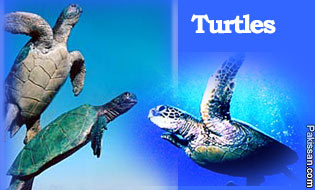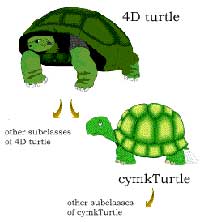|
Turtles; an amazing
specie
Reptiles are the animals, which
can lead a dual life; both in water and on land for example
frogs, crocodiles, snakes, turtles, alligators and a long list
that is of great interest.
Well from the word “Reptile”, I don’t know much about its
origin or its meaning, but what I understand from it, it is a
combination of two words “Repeat” and “Tile” that accords with
the scaly skin of most of these phylum’s animals as we see
scales repeated on snakes, similar spots are found on frogs,
toads and crocodiles have amazing skin as well and so on….
This particular article is related to a wonderful reptile
commonly known as turtle or tortoise…

Turtle is the word that is mostly applied to the organism with
shell passing most of its lifetime in water but tortoise is
the one that moves most of the time on land. Turtle though
normally seems to be a single similar organism but there are
about 270 living species found up till now which are grouped
into 12 or 13 families. They are widespread and most of them
are cold-blooded animals but one exception is of that of the
leather back turtle, it has a peculiar built of oily fat layer
under the skin with a large size that helps it to keep its
temperature constant.
Shell is, not only an attribute to turtles as many other
animals of phylum mollusca also possess shells, but even in
different species of turtles shells do vary from each other
that accords to their mode of life. Tortoises, which have to
live on land and dry environment, they possess a hard heavy
shell while turtles have a lightweight shell particularly
special aquatic turtles have a peculiar streamlined shell that
help to swim faster. Shell consists of an outer layer that may
be called as the epidermis of turtle and an inner layer that
is made up of ribs a part of vertebral column that makes up
almost a count of 60 bones that is why a turtle or tortoise
cannot crawl out of the shell. Shell lower part that is called
a plastron supports the belly while top part is called as
carapace.
Carapace is of variety as well as plastron. In some turtles
this shell possesses horny scales called as scutes that are
composed of Keratin protein. In some species these scutes
overlap the spaces between bones of shell adding strength to
them. Some turtles’ shells possess hinges for providing
flexibility to them for easy faster movement like turtles of
Canada and Northeastern United States including American Box
turtle whose plastron has single hinge while that of American
Mud turtle possess many hinges. Regarding the shape of shells
they are streamlined, pancake shaped, and shells with
cross-shaped plastrons and many other small variations also do
exist according to the life style of turtle.
Now another amazing aspect of turtle is the way they use to
protect themselves against all hazards, that is they hide
themselves in the strong shell Nature has provided them. What
we see is that they hide their necks in the shell and limbs as
well, scientists see two ways in which they hide their necks,
one way is side-wise and the other is U-shaped. In the
U-shaped style they swing their neck into the shell and remain
above the axis of vertebral column, while in side-wise method
they make an S-shape curve perpendicular to the vertebral
column.
Interesting also is the way they breathe in air. Unlike other
breathing organisms their ribs do not move inside and outside
to decrease or increase the volume of their chest cavity
rather their ribs, as mentioned above, are fixed to make-up
the inner layer of their shell. It is only the muscles of
their chest cavity and pectoral and pelvic girdles (fore-limb
and hind-limb) that contract and relax to perform the function
of a flexible rib cage in other animals. Also some aquatic
species and tortoises, which spend their part of time in
water, make use of the oxygen dissolved in water. Some
exclusively aquatic turtles do store oxygen in their lungs, in
their body cavity and in a part of body called as cloaca, this
happens so during hibernation period normally.

Digestive system is well developed according to the mode of
diet and diet is modified according to the mode of life. In
some individuals there is a capacity of long time storage
while some possess good speed of digestion. All the ingesta
are grind by the stomach enzymes while the intestine absorbs
all nutrients, however the undigested food is removed through
special opening cloaca. Urinary system does exist and filter
the blood.
Nervous system is very well developed. A very common example
of that is seen some danger approaches a turtle and it hides
itself immediately into its shell. However its ability to see
and recognize colors and patterns is very sharp. Turtle’s eyes
are specialized to see underwater but they can see only to
less distance on land.
If we talk about the reaction of turtles towards the seasons
then we see that like most reptiles they undergo a condition
called Torpor, similar to hibernation that starts almost in
October or November and lasts up till March or April, during
which they reduce their feeding and their oxygen demand is
reduced to very low. On the other hand, most of their
behavioral settings are programmed such that they keep their
body temperature warm. For that mostly the aquatic turtles
come to the sea-banks or beaches for sunbathing. While mostly
terrestrial animals hide themselves in burrows like Eastern
box turtle.
Limbs make a very important physical aspect of turtle that not
only help to walk on land but to swim in water. Limbs of
different species are modified according to their mode of
life, their environment and their need as well.
For example, forelimbs of Gopher tortoise are modified like a
scoop for digging purpose to make burrows. While if we see any
aquatic specie its limbs are found to be well developed for a
smooth swimming, that is they would be having webbed foot that
help them to dive and then spread to cover a large surface
area to escape their enemies. It is an animal that is thought
to be a very slow moving animal as seen by most of land-living
human beings and its speed on land is found to be 0.3mph but
they are very swift swimmer and swim at a high speed of 19mph
however a soft-shelled turtle can swim even faster than a
fish, and sea-turtles are specializing to swim like a ship as
their hind limbs work like radars while forelimbs work as
flippers.
Reproduction is sexual. There is courtship behavior shown by
males for mating. They show interesting moves and now it
depends on females whether they allow mating or not. Even it
happens so that they move away in order to avoid this. Some
species of female turtles store the sperms in their cloaca for
up to four years and can fertile their ova for this time with
a single mating and can lay eggs. Mating may take place on
land or in water but laying and hatching always takes place on
land. Females travel to safer places on land to lay eggs these
places are chosen in order to have suitable temperature,
safety from floods, predators, enemies including man.
They do not actually walk but creep make burrow and lay their
eggs in them and after covering these eggs with dust or sand
females move ahead and take no care of the eggs any more. A
turtle can lay 1 to 200 eggs in a clutch, depends and varies
with species; some small species can lay 1 to 6 eggs in a
clutch. Eggs are round or oval in shape, with thick rigid
shells. Hatching from the eggs takes place in 6 to 8 months
however in some very large species it may reach up to one year
or so. Growth of small hatchlings depends upon the species
that how long do they live.
In the early life growth rate is high but later on it slows
down. Turtles are known to live up to 100s of years, some lead
only to 60 years, however it takes a turtle almost 5 to 20
years to mature sexually i.e. to be able to lay eggs and mate.
An interesting aspect of turtle sex-determination is that
during the buried period of eggs after laying and to hatching
is the temperature. In some species temperature is the factor
that determines the sex of the forthcoming neonate. If
temperature is below 28OC the next turtle would be a male and
if it is above 30OC it will be a female and if it is 29OC
individual may be a male or a female. But in other species the
chromosomes like other mammals and birds determine it.
Last but not the least is the way turtles take their diet,
they are omnivorous. However there are certain species which
are herbivorous and some are carnivorous. Many aquatic
turtles, being good and swift swimmers prey on insects,
snails, worms, minnows, and tadpoles and aquatic plants.
Terrestrial box turtle eat small animals but when ripe berries
are available they eat so much of them that they get fat
enough to hardly compensate in their hinged shells.
Aquatic species that are herbivores go for soft grasses of
water, while some also go for snails and other small-shelled
organisms due to the presence of horny and bony ridges in
their jaws that helps them to crush the shell of their preys
in them. Turtles follow a variety of diets that depends on
species and varies with them.
Now what we have to see is that this good-natured specie is
endangered. They survived the harshness of nature when
dinosaurs were replenished. Now they are in a threat to be
removed form the face of the earth.
However there are different communities, authorities, NGOs and
counsels working for their protection but we particularly in
Pakistan must go for awareness regarding turtles. They are not
getting their due right in our country. We must make a softer
corner for them in our heart and try to save them as they are
a wonderful and loving animal with varying speeds to move in
water and on land as well, as this amazing quality is seldom
find in any other specie on land.
Thanks for the scientists and learned people whose works
helped me to write this article and gave me the opportunity to
share it with my readers.
Dr.Saba Badar Khari
|
Pakissan.com;
|